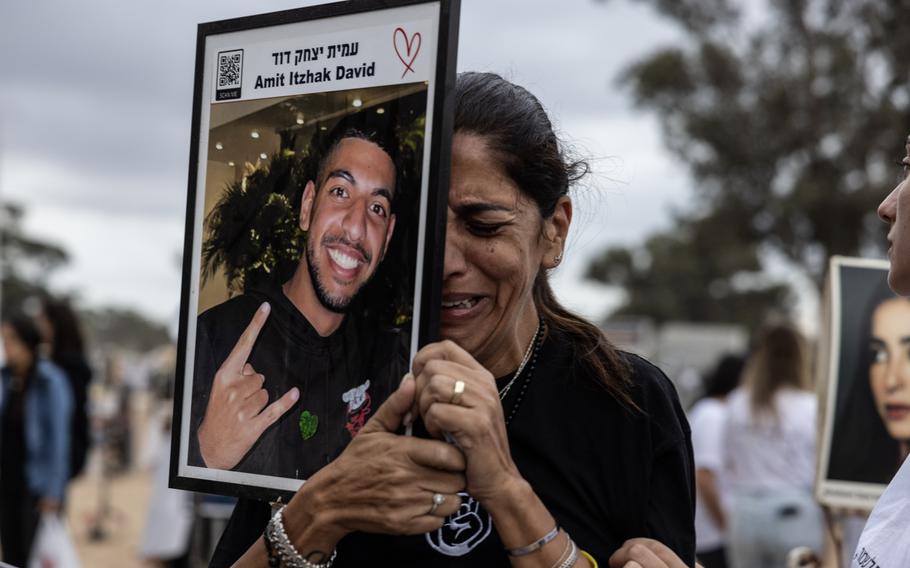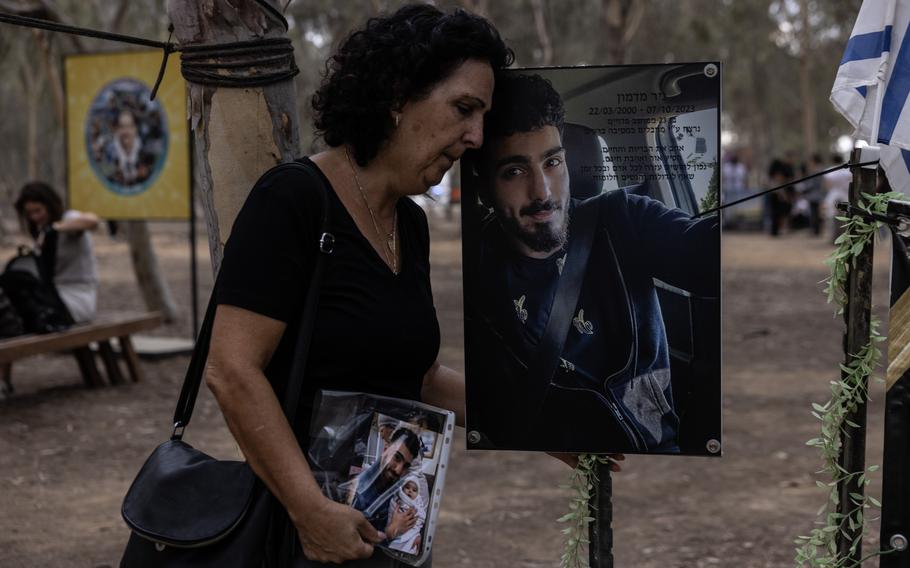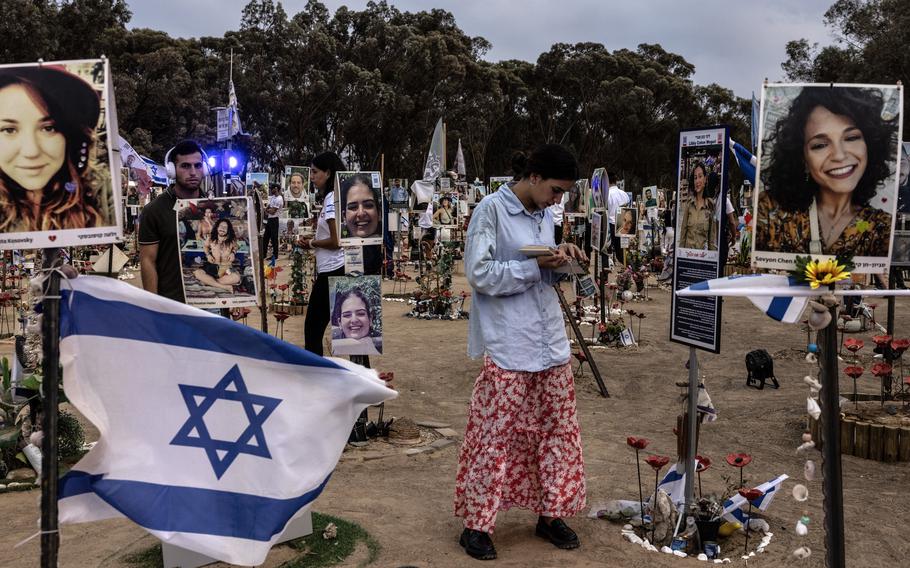Middle East
Israelis, still at war, pause to remember the attacks of one year ago
The Washington Post October 7, 2024

Family members and friends of those killed and abducted by Hamas at the Nova music festival on Oct. 7, 2023, visit the site as Israel marks the anniversary of the attacks. (Heidi Levine for The Washington Post)
JERUSALEM — Israeli communities near the Gaza Strip awoke Monday to commemorate the first anniversary of the Hamas attacks in the same way they were roused on Oct. 7, 2023: to the sound of air raid sirens.
At 6:32 a.m. — almost to the minute of the surprise assault last year — militants in Gaza launched four rockets toward those same kibbutzim, sending Israelis into shelters and highlighting how the battle continues to rage 12 months after that fateful morning.
Israeli forces said they intercepted most of the projectiles and immediately responded by striking targets inside Gaza. At least two minor injuries were reported in Kibbutz Kfar Chabad when a second barrage was fired later in the morning. With evening approaching, a missile from Yemen was intercepted and sirens sounded briefly in Tel Aviv.
As Israel’s military attacked Hezbollah sites across Lebanon on Monday, and the government continued deliberations over how to respond to last week’s Iranian missile strikes, Israelis marked the first anniversary of the deadliest day against Jews since the Holocaust as a country still very much at war.
They came together — in groups of fewer than 2,000 to comply with military orders in much of the country against larger gatherings — to remember those who were lost, those who are still being held captive and those who remain unable to return to their homes. About 1,200 Israeli citizens, visitors, guest workers and soldiers were killed on Oct. 7; at least 250 were taken hostage; more than 160,000 fled to safety from towns around Gaza and along the border with Lebanon. Few have come home.
A crowd of a few hundred people gathered near Prime Minister Benjamin Netanyahu’s house in Jerusalem in a demonstration organized by the families of some of the more than 100 hostages that remain in Gaza. “Stay strong survive,” read one sign.
Others held banners showing photos of their loved ones. At 6:29 a.m. the sound of a siren was played to mark the moment rockets began to rain down on Israel a year ago, before the hostages were dragged from their homes and beds at gunpoint on a holiday morning. The crowd fell silent.
“If someone on Oct. 7 or 8 had told me that a year would pass and 101 hostages would still be in Gaza, and the war would still be going on, I wouldn’t have believed it,” said Eitan Buchvall, 53, a high school teacher who had joined the demonstration before work. “It feels like things are getting worse.”
He held a banner with the name of one hostage, Alon Ohel, who was 22 when he was as kidnapped. His age had been crossed out in black marker and updated: 23.

Ruth Madmon, 60, mourns next to a poster of her son Nir, who was killed Oct. 7, 2023. (Heidi Levine for The Washington Post)
Most in the crowd want a cease-fire deal that would end the fighting in Gaza and see the release of the captives. But a banner hanging from a nearby building read “Deal = Surrender,” a reminder of how deeply divided Israelis have become over how to proceed in what is the country’s longest war since 1948.
At small vigils on thoroughfares, groups waved posters of the captives at passing commuters. “We are all hostages,” the signs read.
By dawn Monday, scores had taken to the fields where at least 364 were killed when Hamas fighters stormed the all-night Nova dance festival. Some carried flashlights as they found their way to the dozens of memorials filling the field, each marked with a portrait of the victim and surrounded by small candles and red ceramic flowers.
One woman collapsed at the base of her child’s photo. Artillery shells boomed under dark clouds.
At 6:25 a.m., loudspeakers aired the song that was playing at the time of the attacks, completing the tune a year later even as rockets flew again.
Across Israel, emotions were raw and anger was a common undercurrent. Many hold Netanyahu’s government responsible for failing to achieve the release of the remaining hostages, and some of the communities devastated on Oct. 7, 2023, refused to take part in the official state memorial service.
The Nova crowd was largely silent when, shortly before 7 a.m., Israeli President Isaac Herzog and his wife approached a display of those killed at the site and lit candles.
Some who survived that morning returned to the places where they had danced in joy and then fled in terror — a scene now transformed with shrines and newly planted trees.
“I think I was there,” one young man, pointing, said to a group of friends who had parked by the road. The hundreds of cars that had been abandoned in the field and surrounding lanes, many covered in bullet holes and blood, have been removed to an empty lot several miles away.

A young woman prays amid portraits affixed to wooden sticks of those killed on Oct. 7 near Kibbutz Re’em, Israel. (Heidi Levine for The Washington Post)
The day also brought news of another Nova festival death. The hostage family umbrella group announced that Idan Shtivi, 28, who was credited with helping two other attendees escape, was killed on Oct. 7 and his body was still being held in Gaza.
A helicopter buzzed overhead. Just a few miles away, the fighting that Israel launched inside of Gaza within hours of the attack last October went on. Black smoke rose over the enclave.
In a park in south Tel Aviv, instructors guided festival survivors through yoga, ice baths and flower arrangement workshops. Tal Shimony, 26, said she lost 15 friends that day; two more are still held as captives.
“It’s PTSD, but also beyond PTSD,” she said, like she “was reborn on Oct. 7, and now I am 1 year old, just learning how to handle the universe.”
In Gaza, weeks of punishing airstrikes followed by 10 months of ground operations have degraded Hamas militarily, but have not achieved Netanyahu’s stated goal of destroying the group. Tens of thousands of people have been killed across the shattered enclave, many of them women and children, and more than 2 million civilians are locked in a grueling cycle of displacement, hunger and disease. 346 Israeli soldiers have died fighting in Gaza.
In a statement, the United Nations Office for the Coordination of Humanitarian Affairs decried what it called “a year of unimaginable suffering.”
“Entire Israeli communities have been displaced, living under the constant threat of indiscriminate rocket fire,” OCHA said. “In Gaza … Israeli military operations have resulted in a catastrophe.”
For Gazan civilians who have survived a year of war, the date returned with no hope in sight for an end to the death and misery.
Most families have been displaced multiple times, forced into smaller and smaller areas by Israeli bombardments and evacuation orders. On Monday, residents near the Khan Younis refugee camp in southern Gaza were told again to leave.
“This is my fifth time to be displaced,” Mohamed Abu Taha, 41, originally from Rafah, said in a phone interview. “This is a terrible day.”
He described the last year of chasing safety and food, both elusive. A green pepper now costs $7, he said. Humanitarian aid barely trickles in through crossings controlled by Israel, he said, and bandits steal much of what does.
“Is there hope this nightmare ends?” he asked. “We have no energy left.”
Abeer Maher, 36, is living in a tent in the Deir al-Balah refugee camp in central Gaza with her three children, one with hepatitis, another covered with a Streptococcus rash. Once top students, they haven’t been in school since Oct. 6 — their “last day of safety and reassurance.”
“Please pray for us,” Maher said. “It is now like the first day of war.”
Hamas, meanwhile, released a statement hailing the “glorious 7th of October” as a “milestone” and pledged to keep fighting.
In northern Israel, workplaces and schools remained closed Monday. In other places, armed parents organized security shifts at school entrances. Some parents created phone trees to scramble babies and toddlers to shelter in case of air raids.
Israel’s leaders warned citizens that the next year was unlikely to be easier than the last.
“This is a long war, measured not only by capabilities but also by the willpower and perseverance over time,” Israel’s Army chief of staff, Lt. Gen. Herzi Halevi, said in a statement Sunday. But “for our enemies — every month, every week, and every day is worse than the one before.”
On Monday night, a memorial ceremony organized by the hostage families was broadcast on all major television networks. A rabbi recited the Kaddish, a Jewish mourning prayer, on a stage flanked on one side by cars charred in the Oct. 7 attack and, on the other, by a swing, representing the hundreds of homes turned into battle zones that day.
Testimonies aired on a large screen, paying tribute to the lives lost, and the lives seemingly still on hold. “I still don’t know how to rise from my personal tragedy, but I know that we need to rise from this tragedy together,” said Yigal Cohen, whose daughter Hadar was among the female soldiers killed at the military base in Nahal Oz, less than a mile from Gaza.
He released white balloons into the night sky, then five yellow balloons to honor each of the female soldiers still held by Hamas.
Several of the Israeli towns near Gaza held their own smaller ceremonies. Survivors from Kibbutz Beeri, where more than 130 people were killed, met for a rare town gathering; only a few have returned to the community. The event was largely closed to outsiders as residents walked past burned and shattered houses. They wore hats reading “Now” as a plea to free the remaining hostages, including 10 from Beeri. Only three of those are thought to still be alive.
Down the road in Kibbutz Nir Oz — where 57 were killed and 76 kidnapped, according to a community spokesman — residents and visitors gathered as warplanes flew overhead and tank fire sounded in the distance.
Lotan Cooper, 46, was planting a sapling across from the cemetery where so many of the gravestones bear the date Oct. 7, 2023. His father, Amiram Cooper, who helped found the kibbutz in the 1950s, was one of those kidnapped from Nir Oz, as was his wife, Nurit. She was freed after 17 days in Gaza. Amiram died there.
New trees are part of how his town will heal, though no one knows how long it will take.
“I am very connected to the place, in all my body and my heart,” Cooper said. “Everyone wants the place to grow up again.”
Berger reported from Kibbutz Beeri, Parker from Kibbutz Nir Oz, Mahfouz from Cairo and Rubin from Tel Aviv. Hajar Harb in London and Ilan Ben Zion in Kibbutz Nir Oz contributed to this report.